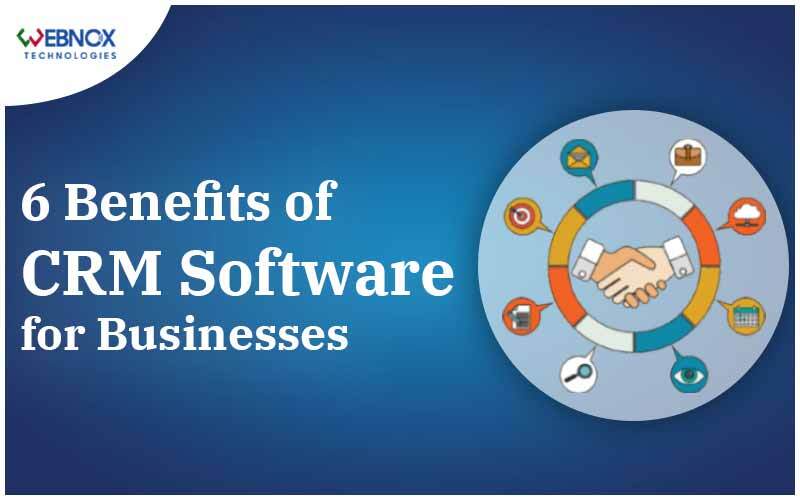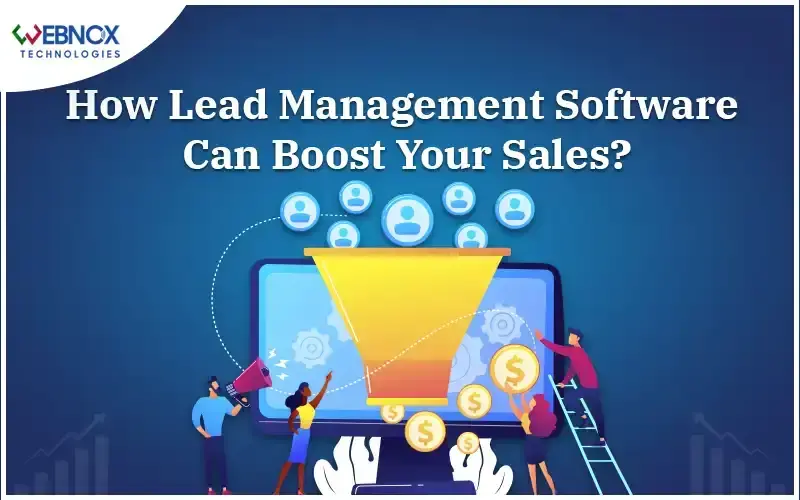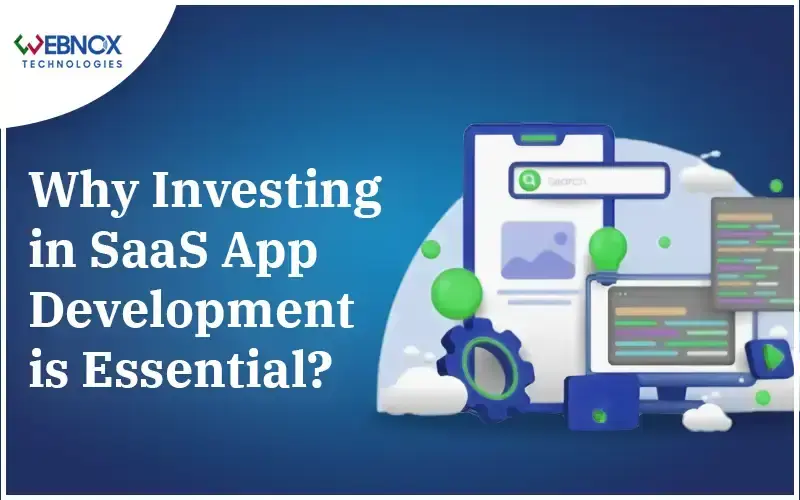Beginner’s Guide to SaaS App Development
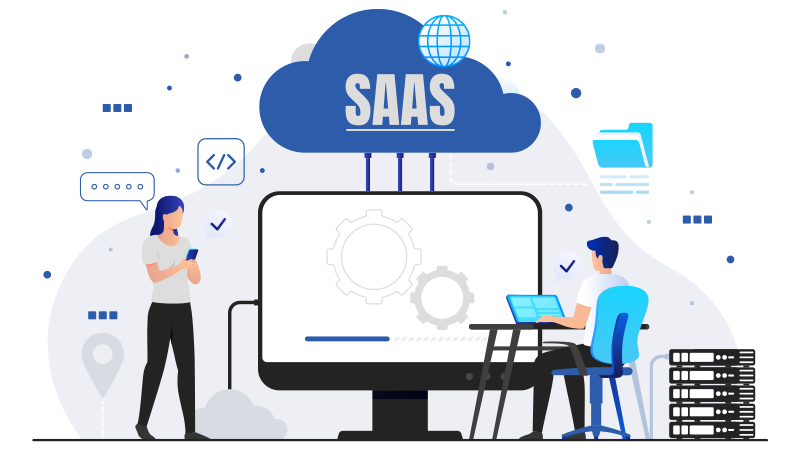
Abinaya // 13-11-2023
Beginner’s Guide to SaaS App Development
What is SaaS?
Software as a service (or SaaS) is a way of delivering applications over the Internet—as a service. Instead of installing and maintaining software, you simply access it via the Internet, freeing yourself from complex software and hardware management.
SaaS is also known as:
- On-demand software
- Web-based software
- Web-hosted software
SaaS is one of the three main categories of cloud computing, alongside:
- Infrastructure as a service (IaaS)
- Platform as a service (PaaS)
How does Software as a Service Operate?
SaaS products are centrally hosted by a provider, who also maintains and updates the software automatically. Customers access and use them via the web and mobile browsers.
Tips and Best Practices for Beginners
1. Coding Efficiently
a. Modular and Scalable Code: Break down the code into smaller, manageable modules. This approach, often known as modular programming, helps in better organization and maintenance. Writing scalable code allows the application to grow without major rewrites.
b. Follow Best Coding Practices: Stick to best coding practices, including writing clean and readable code, using meaningful variable and function names, commenting for clarity, and following established coding conventions in the chosen programming language.
c. Optimization and Performance: Consider efficiency and performance from the beginning. Optimize code for speed and resource utilization, for example by reducing unnecessary loops, improving algorithms, or caching where appropriate.
d. Version Control and Documentation: Utilize version control systems like Git for tracking changes in the codebase. Additionally, maintain comprehensive documentation for the code to help future developers understand the application.
2. Testing For Quality Assurance
a. Testing Types: Understand and implement various testing types like unit testing, integration testing, and end-to-end testing. Unit testing ensures individual components work as expected, integration testing checks how different components work together, and end-to-end testing evaluates the whole application’s functionality.
b. Test-Driven Development (TDD): Consider TDD where tests are written before the code. This methodology helps ensure the code meets the intended requirements and makes it easier to identify issues early in the development process.
c. Automation and Continuous Integration/Continuous Deployment (CI/CD): Use automation tools for testing. Implement CI/CD pipelines to automate the testing process, ensuring frequent integration of code changes and continuous deployment of tested code to production.
d. Bug Tracking and Resolution: Maintain a system for tracking and resolving bugs efficiently. Use bug tracking tools to log and prioritize issues, which aids in their swift resolution.
3. Tips for Project Management
a. Agile Methodologies: Consider using Agile methodologies such as Scrum or Kanban. These methodologies help in iterative development, allowing for flexibility and adaptation to changes in project requirements.
b. Clear Goals and Milestones: Set clear project goals and define achievable milestones. Breaking down the project into smaller tasks and achieving them gradually helps in maintaining focus and progress.
c. Effective Communication: Ensure effective communication within the development team. Use collaborative tools and hold regular meetings to discuss progress, roadblocks, and solutions.
d. Risk Management: Identify potential risks early in the project and develop strategies to reduce them. Regularly review and adjust the project plan as needed.
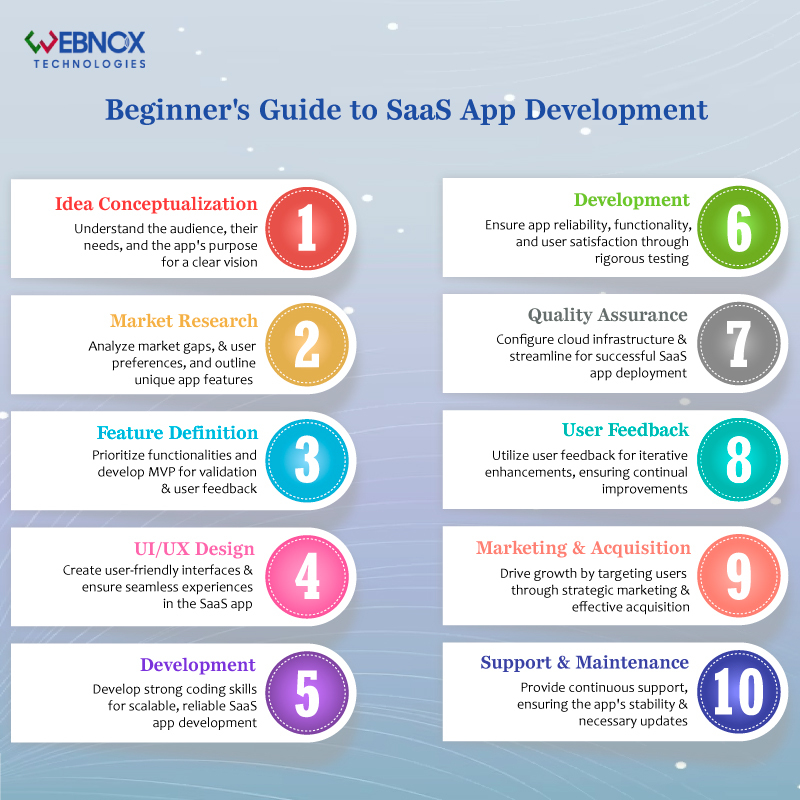
End-To-End SaaS App Development Process
1. Idea Conceptualization
The initial phase of idea conceptualization is where the app’s vision and objectives are carefully formulated. It involves deeply understanding the target audience, their challenges, and the specific problems the app intends to address. This stage establishes the groundwork for a detailed roadmap that harmonizes the app’s purpose with the actual needs of its users.
2. Market Research and Planning
Thoroughly analyzing the market is very important. This involves studying what already exists, understanding what users like, and finding areas where there are opportunities. Creating a clear plan that lists the main features of the app and what makes it special is essential for making smart decisions about how to succeed in the market.
3. Feature Definition and MVP Development
Identifying, outlining, and prioritizing functionalities for a product. MVP development is the initial version that includes core features to validate the concept. This process ensures a streamlined product with essential functionalities for early testing and user feedback before further development.
4. Creating a User-Friendly Experience (UI/UX)
It’s really important to make the app’s interface feel natural and interesting for users. This means making it simple and enjoyable, so people like using it. When the app is easy and friendly to use, it becomes natural and looks good too, making it even more appealing.
5. Coding & Development
During the coding stage, ideas are transformed into the technical foundation of an application. This phase focuses on constructing a dependable and practical app by implementing strong technical solutions. Coding is where the abstract concepts become the working reality of the application, ensuring its reliability and effectiveness.
6. Testing and Quality Assurance
Comprehensive testing ensures the app functions seamlessly. Identifying and resolving issues before the launch phase guarantees a superior user experience, focusing on accurate testing to capture and rectify any functional or usability issues.
7. Deployment and Infrastructure Setup
Launching the app into the market requires a robust infrastructure setup. Whether through cloud services or dedicated servers, this stage concentrates on ensuring a smooth, stable deployment that can support the app’s functionality and scalability needs.
8. User Feedback and Continuous Improvement
Consistently listening and integrating customer feedback is significant for continuous app enhancement. Feedback from users helps make ongoing improvements to the app, keeping it in line with the changing needs and preferences of customers.
9. Marketing and User Acquisition
SaaS marketing heavily relies on promotion and achieving strategies to attract customers. This phase concentrates on strategic marketing efforts aimed at reaching a specific audience and customizing ideas and products to match the needs of the target market.
10. Support and Ongoing Maintenance
Providing continuous support and necessary updates ensures the app’s smooth functionality and stability. Ongoing maintenance plans secure the app’s relevance and alignment with user needs in the long run, enabling seamless user experiences and sustained customer satisfaction.
Key Advantages of SaaS Application Development
1. Cost-Effective Scalability
With SaaS, you only pay for what you need. It’s like buying just the right amount of food for a party—you don’t have to get more than you’ll use. As your business grows, SaaS grows with you without big upfront costs.
2. Easy to Use Anywhere
SaaS works from anywhere with an internet connection. This means your team can work from home, a coffee shop, or anywhere they need to. It’s like taking your office everywhere you go.
3. Quick and Easy Updates
SaaS solutions generally have quicker implementation times compared to traditional software. Updates and maintenance are handled by the service provider. This means you get access to the latest features and security updates without the hassle of managing these aspects internally.
4. Focus on Core Business Operations
Software as a Service allow your business to concentrate on its core competencies. By outsourcing the management of the software to the SaaS provider, you can allocate more time and resources to improving your business, developing strategies, and enhancing customer experiences rather than dealing with software-related issues.
5. Safety and Rules Covered
Saas development companies really focuses on keeping your information safe from bad guys. They also make sure they’re doing things the right way, according to the rules. As your business gets bigger, they make sure to beef up their security to keep up with your needs, which gives you and your customers peace of mind.
Conclusion
In conclusion, the guide underscores the significance of SaaS in revolutionizing software access and outlines a structured process for developing SaaS applications. Software as a Service emphasizes the importance of understanding user needs, employing best coding practices, comprehensive testing, effective project management, and ongoing customer engagement for successful SaaS app development.
Begin your SaaS app journey today! Learn, innovate, and create user-centered solutions. Embrace the evolving landscape of software development with us. Let’s craft meaningful, efficient applications together, shaping the future of technology!


